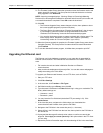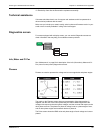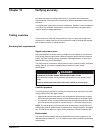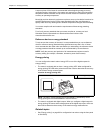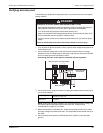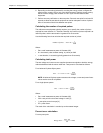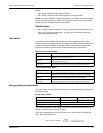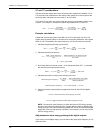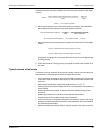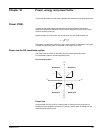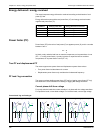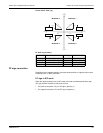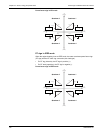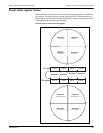
132 HRB1684301-01
Chapter 15—Verifying accuracy PowerLogic™ PM5500 series user manual
VT and CT considerations
The test points are always taken at the secondary side, regardless of whether VTs or
CTs are used. Ptot is derived from the values of the voltage and current inputs at the
secondary side, and takes into account the VT and CT ratios.
If VTs and CTs are used, you must include their primary and secondary ratings in the
equation. For example, in a balanced 3-phase Wye system with VTs and CTs:
Example calculations
A balanced 3-phase Wye system uses 480:120 volt VTs and 100:5 amp CTs. The
signals at the secondary side are 119 volts line-to-neutral and 4.99 amps, with a power
factor of 0.85. The desired pulse output frequency is 20 Hz (20 pulses per second).
1. Calculate the typical total output power (Ptot):
2. Calculate the pulse constant (K):
3. At full load (200% of nominal current = 10 A) and power factor (PF = 1), calculate
the maximum total output power (Pmax):
4. Calculate the maximum output pulse frequency at Pmax:
5. Check the maximum pulse frequency against the limits for the LED and digital
outputs:
NOTE: The maximum pulse frequency is within the limits for LED energy pulsing.
However, the maximum pulse frequency is greater than the limits for digital output
energy pulsing. Pulse output frequencies greater than 25 Hz will saturate the digital
output and cause it to stop pulsing. Therefore in this example, you can only use the
LED for energy pulsing.
Adjustments to allow energy pulsing at the digital outputs
If you want to use the digital output, you must reduce the output pulse frequency so it is
within the limits.
Ptot 3 VLN
VT primary
VT secondary
--------------------------------- I
CT primary
CT ondarysec
-----------------------------------PF
1 kW
1000 W
-------------------=
Ptot 3 119
480
120
--------- 4.99
100
5
--------- 0.85
1 kW
1000 W
------------------- 121.14 kW==
K
3600 (pulse frequency)
Ptot
------------------------------------------------------------
3600 second/hour 20 pulses/second
121.14 kW
------------------------------------------------------------------------------------------==
K 594.4 pulses/kWh=
Pmax 3 119
480
120
--------- 10
100
5
---------1
1 kW
1000 W
------------------- 285.6 kW==
Maximum pulse frequency
K Pmax
3600
------------------------
594.4 pulses/kWh 285.6 kW
3600 seconds/hour
--------------------------------------------------------------------------==
Maximum pulse frequency 47.2 pulses/second 47.2 Hz==
47.2 Hz
·
LED maximum pulse frequency (2.5 kHz)
47.2 Hz
·
digital output maximum pulse frequency (25 Hz)



